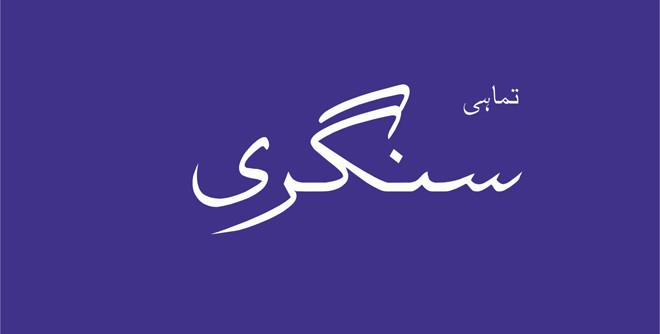Mahmood Awan (The News on Sunday, 20th July 2014)
What does these names tell us about Punjab and why names are so important needs a separate space. But if a word, expression or name is capable of connecting someone to his/her roots, history, heritage or home, those names are much more than hollow sounds and crude alphabetics. There are a few names which had always created an immense sense of security, rootedness, pleasure and longing in me; a simple mention of these words connects me instantly to the land of my soul: Tahli, Jand, Phulahi, Pippal, Vehda, Beri, Kannak, Dudh, Dhol, Luddi, Mahiya, BhaiN, Nikka, Ravi and so many more.
Sangry is one of those names and when I first saw it printed on a magazine cover in 2011, the whole Punjab became alive within me. Sangry are pods/shells of the Prosopis cineraria tree or Jand tree as we call it in Punjabi and nativity of this name was so artistically merged with fertility of the magazine contents that the whole west Punjabi literary landscape became green for a while.
Publication history of Punjabi literary magazines is quite intriguing, full of closures and arrivals. Hira Singh Dard’s Phulvãri is considered the first ever Punjabi magazine published from Amritsar in Gurmukhi script in 1924. The pioneer Punjabi magazine in Farsi script is believed to be Joshua Fazal Din‘s Punjabi Darbãr followed by much acclaimed, Bhola Nath Waris’s Sarang. There was a time when each educational institute used to have dedicated Punjabi sections and, in a few cases, complete issues appeared in Punjabi. Government College Lahore’s Rãvi even had a regular Gurmukhi script section (which was later removed) and once as student editor in 1972-73, Mushtaq Soofi edited a complete issue of Rãvi in Punjabi.
Punjabi magazines have mostly been non-commercial volunteer efforts. Without any institutional support and sponsorships most of these magazines couldn’t sustain their publication on regular basis and there is a long list of those which appeared and disappeared from the west Punjabi literary scene.
Under Martial Law regimes when declarations for Punjabi publications were almost impossible Kitãb Larri’s (Book Series) were introduced, Rut Lekha in the 1970s was one such effort by then students of Punjab University, Lahore. In later years LehrãN, Punjabi Adab, MaaN Boli, Sver and Puncham kept us afloat with all their inadequate resources and limitations.
Space for a new Punjabi magazine that could bring a fresh lingual and literary perspective was always there and Sangry provided that much needed alternative with its first publication in October, 2011. It was launched as a quarterly and so far nine issues have appeared. It has given a new look to the Punjabi magazine printing and editing. Its editorial team comprising Zaheer Watto, Faisal Jappa and Fayyaz Mighiana is young, committed and scholastic. All three of them are teachers of Punjabi and are serving in different colleges of Lahore and Faisalabad. They are students of Professor Saeed Bhutta whose encouragement and guidance provided them the inspiration for this mighty effort. They are from the heartland of the Punjab and are well connected to both urban and rural literary traditions. They are open, approachable and welcoming.
Sangry is printed in paperback with pages count of 150 to 180. It is divided into different literary sections. Essays, poems, folk narrative, short stories, conversations and interviews, novel and Bãr Rang (Colours of the Bar) are the main sections appearing in each issue.
In some issues, a dedicated author section was also introduced where works of fiction writer Jinder, poet Afzal Saahir and Abdul Muqeet Bhatti were appreciated. Current issue has a section dedicated to Saeed Bhutta’s folk works. Jaswinder Singh’s novel Mãt Lok (People of the world) is being made available to its readers after transliteration. Punjabi translations of global poets like Anna Akhmatova, Seamus Heaney, Ahmad Shamlou, Mehdi Akhavãn-Sãles and Menna Elfyn have also appeared in various issues of Sangry. Masood Khalid’s essays on Punjabi classics are a delight to read. Sangry contributors are from all over Punjab and it is giving space to all dialects of Punjabi from Shahpuri to Saraiki.
In a province where bulk of the Punjabi writers and teachers don’t bother to buy any Punjabi magazine or book and are always on a hunt to get hold of a free complimentary copy, main challenge for Sangry will be to sustain itself financially on its own. Other magazines in the market have their long standing support system and for these ‘outsiders’ financial stability will be an uphill task. They have to find an out of the box solution to not only create a new paid readership but also interface directly with those who are passionate about Punjabi especially the youth. They will also have to avoid the curse of inconsistent and irregular publication cycles which have become a trademark of the current lot of magazine printers keeping quality of the published contents supreme.
With the revival of Punjabi Adab by Mushtaq Soofi and the arrival of Sangry, Puncham and Sver, we as Punjabi writers are in safe hands perhaps for the first time in our post partition literary history. But as we know it’s just a start and looking at the sad history of Punjabi magazines, fears of Sangry supporters are not that misplaced. All depends upon this outstanding Sangry team on how long can they survive and survive gracefully.
——————————————-
Published on 20th July 2014 on The News on Sunday Literati Page.
https://www.thenews.com.pk/tns/detail/556696-sangry-magazine-an-outstanding-addition
——————————————


